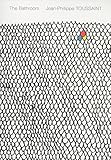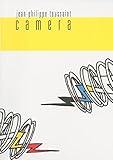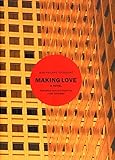 Were I to claim that Jean-Philippe Toussaint shared a certain amount of common ground with Ian McEwan, I might be in danger of coming off as flippant or, worse, willfully obtuse. Toussaint, after all, is a Belgian avant-garde novelist known for his radically plotless books that seem intent on revealing as little as possible about their protagonists. McEwan is a purveyor of skillfully propulsive novels about upper-middle class English people, who has — fairly or unfairly — become synonymous with upper-middlebrow literary fiction. Toussaint is an exemplar to those of us who want to see the novel being taken to places it has not yet been. Ian McEwan is a writer whose books David Cameron has used for PR purposes (he once arranged to have himself photographed on a suspiciously empty tube between Epping and Charing Cross, cross-legged and suavely engrossed in On Chesil Beach). It’s the kind of comparison that could easily be mistaken for an attention-grabbing stunt. But I’m going to make it anyway — in good faith, I assure you — because it’s one that kept occurring to me as I read Toussaint’s brilliant and compelling The Truth About Marie, the latest of his novels to be translated into English.
Were I to claim that Jean-Philippe Toussaint shared a certain amount of common ground with Ian McEwan, I might be in danger of coming off as flippant or, worse, willfully obtuse. Toussaint, after all, is a Belgian avant-garde novelist known for his radically plotless books that seem intent on revealing as little as possible about their protagonists. McEwan is a purveyor of skillfully propulsive novels about upper-middle class English people, who has — fairly or unfairly — become synonymous with upper-middlebrow literary fiction. Toussaint is an exemplar to those of us who want to see the novel being taken to places it has not yet been. Ian McEwan is a writer whose books David Cameron has used for PR purposes (he once arranged to have himself photographed on a suspiciously empty tube between Epping and Charing Cross, cross-legged and suavely engrossed in On Chesil Beach). It’s the kind of comparison that could easily be mistaken for an attention-grabbing stunt. But I’m going to make it anyway — in good faith, I assure you — because it’s one that kept occurring to me as I read Toussaint’s brilliant and compelling The Truth About Marie, the latest of his novels to be translated into English.
I don’t mean to imply that Toussaint is really an upper-middlebrow novelist masquerading as an avant-gardist (he’s definitely not), or that he shares a sensibility or a set of artistic objectives with McEwan. They present the reader with very different kinds of experience, and demand very different intensities of reading. But they are each in possession of a rare and remarkable gift for creating stunning standalone scenes that involve the steep deceleration of narrative time. McEwan’s long and absorbing set-pieces — Enduring Love’s hot air balloon disaster, the battle scene in Atonement, the disappearance of the child in the opening pages of The Child in Time — are, famously, the best thing about his books.
The truth about The Truth About Marie is that it is essentially one set-piece after another. It’s divided into three distinct parts. The first details the events of a single night, during which Jean Christophe de G., the wealthy lover of Marie (the ex-girlfriend of the unnamed narrator) suffers a massive heart attack in her apartment and dies on the spot. In her state of panic, she phones the narrator, who leaves his flat just half a mile away (where he has been making love to another woman, also named Marie) and walks through a Parisian downpour to be with her in the apartment they used to share. The second part jolts us back to the beginning of Marie and Jean-Christophe’s affair. It’s this section that really showcases Toussaint’s spooky powers of chronological manipulation, his idly urgent exploration of the vast spaces of a single moment. In a sequence that accounts for almost half the length of this short novel, the narrator (who offers us no plausible assurance of the reliability of his testimony) comprehensively details an occurrence at which he himself was not present: the transportation via cargo plane of a racehorse, owned by Jean-Christophe, from Tokyo to Paris. In the third part, Marie invites the narrator to come and stay with her in Elba at the home of her recently deceased father, and a forest fire breaks out that threatens to consume them. The novel, in other words, is three show-stopping climaxes specifically not in search of a plot. It’s as though the best, most audacious bits of McEwan’s books had been extracted from the stories of which they serve as centerpieces, in order to be fastened loosely together into some wholly strange and original (nouveau) nouveau romanesque construction.

 The Truth About Marie reveals its author’s perennial obsession with the tensions between motion and stasis, which is, as always, nested within a larger concern with the inescapable progression of all bodies towards immobility, and all lives towards death. (Even in the earlier, more whimsically comic works like The Bathroom and Camera with which Toussaint made his name in the 1980s, there is always this slow, quietly horrified circling of the abyss of mortality.) When the paramedics arrive and attempt to resuscitate Jean-Christophe de G. with a defibrillator — to reverse, as it were, his body’s progression from movement to stillness — Marie observes the failure of this attempt, and her lover’s lifeless body is suddenly revealed to her, laid bare in the fullest sense of the term:
The Truth About Marie reveals its author’s perennial obsession with the tensions between motion and stasis, which is, as always, nested within a larger concern with the inescapable progression of all bodies towards immobility, and all lives towards death. (Even in the earlier, more whimsically comic works like The Bathroom and Camera with which Toussaint made his name in the 1980s, there is always this slow, quietly horrified circling of the abyss of mortality.) When the paramedics arrive and attempt to resuscitate Jean-Christophe de G. with a defibrillator — to reverse, as it were, his body’s progression from movement to stillness — Marie observes the failure of this attempt, and her lover’s lifeless body is suddenly revealed to her, laid bare in the fullest sense of the term:
Falling back onto the floor, the body lay motionless, and Marie understood then that Jean-Christophe de G.’s heart had stopped beating. Marie approached the paramedics and looked down at the stripped body, its face hidden by the oxygen mask, its white inanimate flesh dotted with electrodes, skin like a fish, cod or flounder, and Marie couldn’t help thinking that it was this same motionless body that she’d held in this room less than an hour earlier in that very spot, this body stripped naked and dispossessed, objectified by a whole array of medical apparatuses, shaved, hooked to an IV and ventilator — this body reduced to its bare substance, bearing no sign of Jean-Christophe de G.’s personality. She realized then that up until this moment she hadn’t really looked at his body, not once throughout the whole night, not even while making love had she taken an interest in his body, she’d hardly even touched it, hadn’t paid it the least attention, being concerned as she always was with her own body alone, caring only for her own pleasure.
The word that keeps impressing itself upon the reader here is “body.” It appears eight times in three sentences. The passage is a kind of narrative still life, in which the facticity of death, the pallid truth of what we are, is stared down. Marie is apprehending this man as though for the first time here, really seeing the condition of his existence at the precise moment at which that existence has ceased. What she is looking at, in other words, is a thing — a thing that, without her ever beginning to appreciate it, has always been a thing — a body revealed and “objectified” by the epiphenomena and appurtenances of sudden death. Here and elsewhere, Toussaint’s beautifully ruthless descriptions reveal the seemingly paradoxical way in which a death at once conceals and lays bare what a person, every person, actually is. As the narrator reaches Marie’s apartment, he passes the paramedics as they carry Jean-Christophe’s body to the ambulance, and he does not know who or what he is seeing on the stretcher. All he knows is that he has been summoned by a panicked Marie, and that now he is seeing a body being removed from her building — a body which, for all he knows, could well be hers. He then observes some visual details that reveal the form as that of a man. “I gleaned nothing,” he tells us, “but isolated details, focused, removed from their context, caught only in passing, his socks, dark, imposing, as if this man would henceforth be reduced to these, his wrist, horrid, to which the IV was attached, a livid wrist, yellow-hued, cadaverous, his face pale, on which I focused closely, scrutinizing its features to see who this was, but in vain, his face, completely covered by the oxygen mask, was perfectly invisible.”
Jean-Christophe de G. is depersonalized in death, “reduced” to an anonymous aggregation of parts. Most novelists would use this as a starting point for an attempt at reintegration, for a narrative that might endeavor to give this man back the identity taken from him by death. But Toussaint’s narrator makes no such effort, and Jean-Christophe remains a more or less wholly concealed figure (as does the narrator himself, and as does Marie). In fact, he casually informs us at the very beginning of Part II that Jean-Christophe de G.’s real name was actually “Jean-Baptise de Ganay” — a fact gleaned from his obituary in Le Monde — and then reverts anyway, for the remainder of the novel, to calling him Jean-Christophe. There’s something savagely vindictive about this insistence on ignoring the facts of the man’s life. He is denying Jean-Baptiste his real name, using the privileges of narratorship to punish him for his affair with Marie. There’s a lesson in this that might be too awful for us to want to learn, which is that death takes from us not just our lives, but also our right to insist upon a particular version of those lives. What we think of as “our” truths, in other words, are just as provisional and corruptible as what we think of as “our” bodies.
There’s a suspect and slightly creepy moment not much later when the narrator admits that he may have been wrong in many of his assumptions about Jean-Christophe — or “Jean-Christophe” — but insists that he is on much surer ground when it comes to Marie. “I knew Marie’s every move,” he assures us, “I knew how she would have reacted in every circumstance, I knew her instinctively, my knowledge of her was innate, natural, I possessed absolute intelligence regarding the details of her life: I knew the truth about Marie.” As is so often the case with such excessive insistences, this draws attention to precisely the kind of uncertainty it attempts to conceal. The narrator does not, cannot, know “the truth” about Marie. Either there is a truth, and he doesn’t know it — because he wasn’t there — or (more likely) there is nothing like a truth to “know” about a person in the first place, let alone a person who isn’t oneself.
 So the substance of the novel is, necessarily, an indulgence of the narrator’s imagination, as he creates a vivid version of what happened before and after Jean-Christophe’s death. The Japanese section, about the transportation of the racehorse, is by far the most impressive of these. (It takes place, incidentally, just after the events described in Toussaint’s earlier novel Making Love, in which Marie, who is a successful fashion designer, brings the narrator with her on a business trip to Tokyo so that they can take some time out to concentrate on breaking up properly). It focuses much more intently on the horse than on the two human characters. There’s a long, nightmarish sequence in which Marie and Jean-Christophe remain in the hold of the cargo plane with the petrified animal, trapped in a metal container inside a winged metal tube hurtling through a turbulent night sky. The fact that the horse’s name is Zahir is a clue to the position he occupies in the narrator’s mind (Borges’s story “The Zahir,” which is about an object that completely and exclusively occupies the waking and sleeping consciousness of anyone who beholds it, is referenced as the source of his name). This animal, whose raison d’etre is speed, is being kept completely immobile inside a machine that is moving at incomprehensible speed toward a destination that is, to him, likewise incomprehensible. The scene, which seems to illuminate and magnify our powerlessness to escape the trajectory of time and the destination of death, produces in the reader a kind of base animal unease.
So the substance of the novel is, necessarily, an indulgence of the narrator’s imagination, as he creates a vivid version of what happened before and after Jean-Christophe’s death. The Japanese section, about the transportation of the racehorse, is by far the most impressive of these. (It takes place, incidentally, just after the events described in Toussaint’s earlier novel Making Love, in which Marie, who is a successful fashion designer, brings the narrator with her on a business trip to Tokyo so that they can take some time out to concentrate on breaking up properly). It focuses much more intently on the horse than on the two human characters. There’s a long, nightmarish sequence in which Marie and Jean-Christophe remain in the hold of the cargo plane with the petrified animal, trapped in a metal container inside a winged metal tube hurtling through a turbulent night sky. The fact that the horse’s name is Zahir is a clue to the position he occupies in the narrator’s mind (Borges’s story “The Zahir,” which is about an object that completely and exclusively occupies the waking and sleeping consciousness of anyone who beholds it, is referenced as the source of his name). This animal, whose raison d’etre is speed, is being kept completely immobile inside a machine that is moving at incomprehensible speed toward a destination that is, to him, likewise incomprehensible. The scene, which seems to illuminate and magnify our powerlessness to escape the trajectory of time and the destination of death, produces in the reader a kind of base animal unease.
At one point, the narrator happens across Marie and Jean-Christophe at a racecourse in Tokyo, and he observes them without their noticing him. It is not long after he himself has broken up with Marie. “I looked at Marie,” he says, “and it was clear to me then that I was no longer there, that I wasn’t the one with her anymore, this man’s presence revealed nothing if not the reality of my absence. I had before my eyes the striking revelation of my own absence.” This, in fact, is one of the few moments up to that point at which the narrator is actually present for the scene he describes. It becomes a sort of premonitory glimpse at the reality of his own death, and it illuminates the paradoxical way in which his absence has all along been the most overbearing presence in the novel. This is the way Toussaint’s writing achieves its revelations: at first slowly and imperceptibly, and then suddenly and blindingly. It’s a beautiful moment in a strange and unsettling novel that upholds its author’s status as one of the most exciting figures in contemporary fiction.
Bonus Link: Darts and Philosophy, Bowling and Metaphysics: A Primer on the Novels of Jean-Philippe Toussaint








